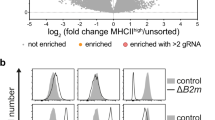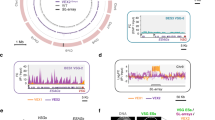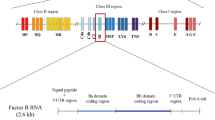Abstract
IT is now possible to paint a detailed picture of how cytoplasmic proteins are handled by the immune system1–7. They are apparently degraded in the cytoplasm into peptides. These are then transported into the endoplasmic reticulum where they encounter class I major histocompatibility complex (MHC) molecules. Once loaded with peptide, the HLA molecules move through the Golgi apparatus to the cell membrane. Until recently, it had not been established how peptides without signal sequences cross the ER membrane. However, a number of papers have now described a pair of membrane transporter genes of the ABC (ATP-binding cassette) super-family which are attractive candidates for this function8–12. Both transporter genes, which may encode two halves of a heterodimer, are situated in the class II region of the MHC. There is evidence that other putative components of the processing machinery, the LMPs (low molecular mass polypeptides), are also encoded in the MHC13–15. Similarities between the properties of the LMPs and a large intracellular protease complex, called proteasome, have led to the suggestion that LMPs are involved in processing antigens16. We have now identified a human gene with sequence homology to proteasome components. Remarkably, this gene maps between the two putative peptide transporter genes.
This is a preview of subscription content, access via your institution
Access options
Subscribe to this journal
Receive 51 print issues and online access
$199.00 per year
only $3.90 per issue
Buy this article
- Purchase on Springer Link
- Instant access to full article PDF
Prices may be subject to local taxes which are calculated during checkout
Similar content being viewed by others
References
Townsend, A. R. M., Gotch, F. M. & Davey, J. Cell 42, 457–467 (1985).
Townsend, A. R. M. et al. Cell 44, 959–968 (1986).
Bjorkman, P. J. et al. Nature 329, 512–516 (1987).
Morrison, L. A., Lukacher, A. E., Braciale, V. L., Fan, D. & Braciale, T. J. J. exp. Med 163, 903–921 (1986).
Moore, M. W., Carbone, F. R. & Bevan, M. J. Cell 54, 777–785 (1988).
Yewdell, J. W. & Bennink, J. R. Cell 62, 203–296 (1990).
Weiss, S. & Bogen, B. Cell 64, 767–776 (1991).
Deverson, E. V. et al. Nature 348, 738–741 (1990).
Trowsdale, J. et al. Nature 348, 741–744 (1990).
Spies, T. et al. Nature 348, 744–747 (1990).
Monaco, J. J., Cho, S. & Attaya, M. Science 250, 1723–1726 (1990).
Spies, T. & DeMars, R. Nature 351, 323–324 (1991).
Monaco, J. J. & McDevitt, H. O. Proc. natn. Acad. Sci. U.S.A. 79, 3001–3005 (1982).
Monaco, J. J. & McDevitt, H. O. Nature 309, 797–799 (1984).
Monaco, J. J. & McDevitt, H. O. Human Immun. 15, 416–426 (1986).
Parham, P. Nature 348, 674–675 (1990).
Kozak, M. Nucleic Acids Res. 12, 857–872 (1984).
McGuire, M. J. & DeMartino, G. N. Biochim. biophys. Acta 873, 279–289 (1986).
Lee, L. W. et al. Biochim. biophys. Acta 1037, 178–185 (1990).
Rivett, A. J. Archs Biochem. Biophys. 268, 1–8 (1989).
Lilley, K. S., Davison, M. D. & Rivett, A. J. FEBS Lett. 262, 327–329 (1990).
Zwickl, P., Lottspeich, F., Dahlmann, B. & Baumeister, W. FEBS Lett. 278, 217–221 (1991).
Tamura, T. et al. Biochim. biophys. Acta 1089, 95–103 (1991).
Rivett, A. J. J. biol. Chem. 260, 12600–12606 (1985).
Tanaka, K., Ii, K., Ichihara, A., Waxman, L. & Goldberg, A. L. J. biol. Chem. 261, 15197–15203 (1986).
Sternberg, M. J. E. Computer Applications in the Biosciences 7, 257–260 (1991).
Barr, P. J. Cell 66, 1–3 (1991).
Sanger, F., Nicklen, S. & Coulsen, A. R. Proc. natn. Acad. Sci. U.S.A. 74, 5463–5467 (1977).
Seed, B. Nature 329, 840–842 (1987).
Argos, P. J. Molec. Biol. 193, 385–396 (1987).
Fuller, R. S., Brake, A. J. & Thorner, J. Science 246, 482–486 (1989).
Ausabel, F. M. et al. Current Protocols in Molecular Biology (Wiley Interscience, New York, 1987).
Author information
Authors and Affiliations
Rights and permissions
About this article
Cite this article
Glynne, R., Powis, S., Beck, S. et al. A proteasome-related gene between the two ABC transporter loci in the class II region of the human MHC. Nature 353, 357–360 (1991). https://doi.org/10.1038/353357a0
Received:
Accepted:
Issue Date:
DOI: https://doi.org/10.1038/353357a0
This article is cited by
-
Mechanistic Pharmacokinetic/Pharmacodynamic Modeling in Support of a Patient-Convenient, Longer Dosing Interval for Carfilzomib, a Covalent Inhibitor of the Proteasome
Clinical Pharmacokinetics (2023)
-
Genetics of antigen processing and presentation
Immunogenetics (2019)
-
Regulation of proteasome assembly and activity in health and disease
Nature Reviews Molecular Cell Biology (2018)
-
The role of the proteasome in the generation of MHC class I ligands and immune responses
Cellular and Molecular Life Sciences (2011)
-
Proteasomes in immune cells: more than peptide producers?
Nature Reviews Immunology (2010)
Comments
By submitting a comment you agree to abide by our Terms and Community Guidelines. If you find something abusive or that does not comply with our terms or guidelines please flag it as inappropriate.



